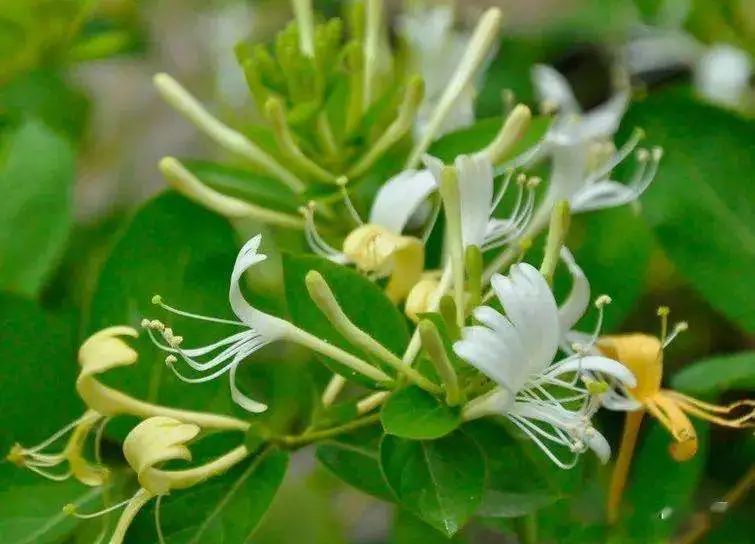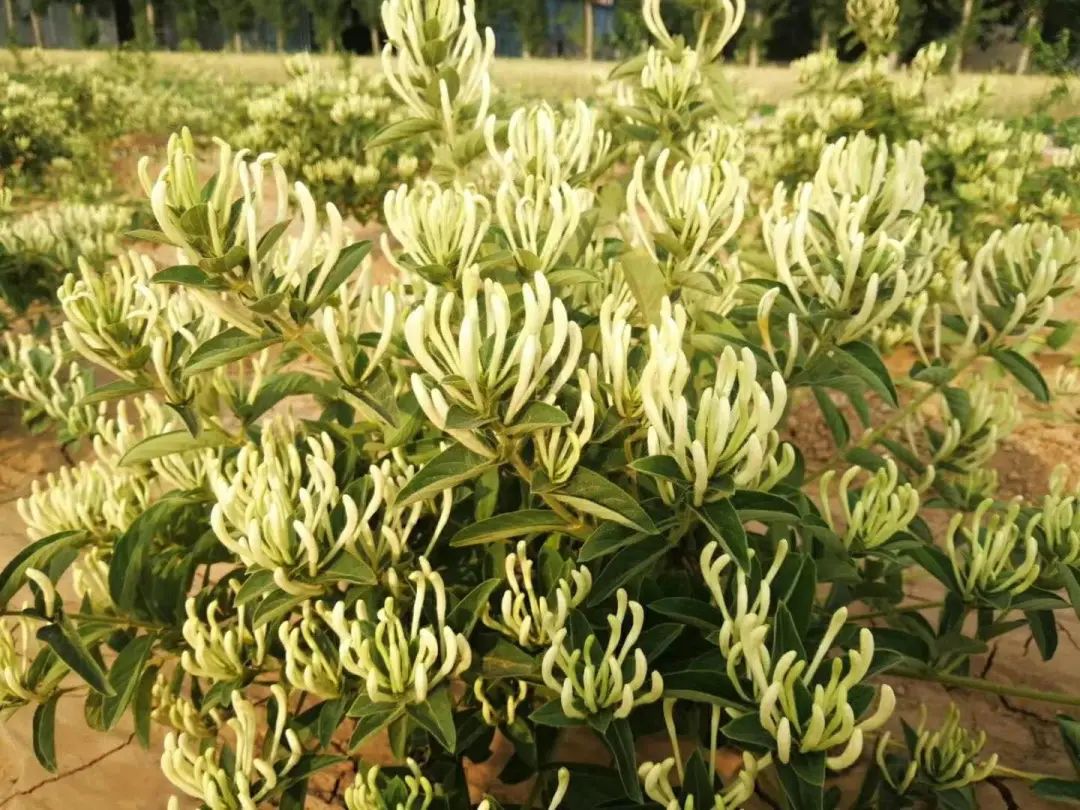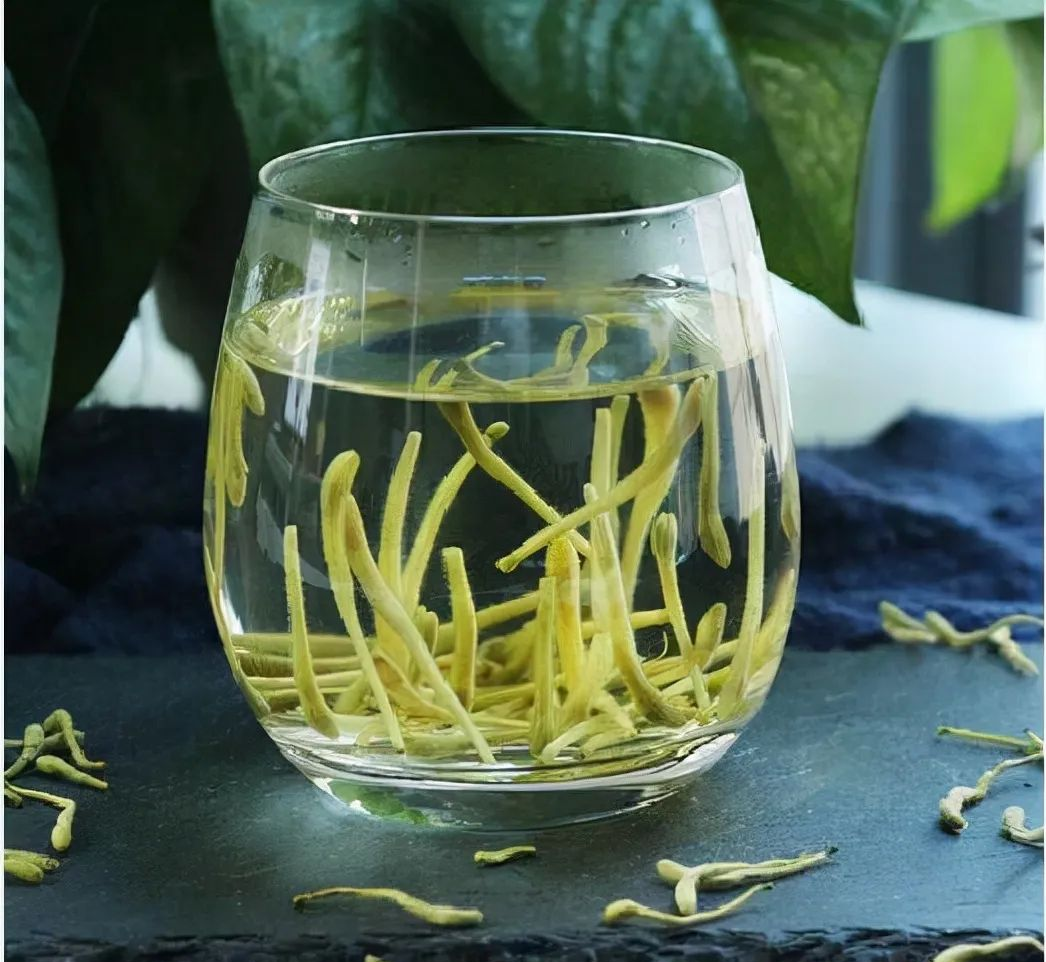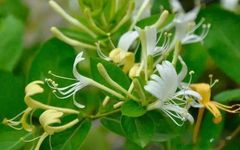The Complete Collection of Traditional Remedies to Promote Health Knowledge
Click below to follow for free↓↓↓
Honeysuckle, also known as Jin Yin Hua (金银花), Ren Dong (忍冬), Yin Hua (银花), and Shuang Hua (双花), has been revered since ancient times as an excellent remedy for clearing heat and detoxifying. It is sweet and cold in nature, aromatic, and clears heat without harming the stomach, while also dispelling pathogens. Honeysuckle can disperse wind-heat and effectively clear blood toxins, making it suitable for various febrile diseases such as fever, rashes, spots, toxic sores, and sore throat.
Overview of Honeysuckle’s Efficacy: Clears heat and detoxifies, cools and disperses wind-heat. It is used for abscesses, sore throat, erysipelas, heat-toxicity dysentery, wind-heat colds, and febrile diseases.

Medicinal Properties of Honeysuckle1. Antibacterial and Antiviral – It has significant inhibitory effects on Staphylococcus aureus, Streptococcus pyogenes, dysentery, typhoid, meningococci, pneumococci, Pseudomonas aeruginosa, and influenza viruses. 2. Immune Enhancement – Honeysuckle promotes lymphocyte transformation and enhances the phagocytic function of white blood cells. 3. Anti-inflammatory and Antipyretic – It promotes the release of adrenal cortex hormones, significantly inhibiting inflammation. Honeysuckle can be categorized into three types: raw, stir-fried, and charred, each with different properties and applications.

Efficacy of Honeysuckle
1. Used for exterior wind-heat or the initial stage of warm diseases. Honeysuckle is sweet and cold, clearing heat from both the qi and blood levels, and has a mild dispersing effect, making it suitable for treating symptoms of exterior wind-heat or the initial stage of warm diseases with unresolved exterior symptoms and excess internal heat. It is often combined with Lian Qiao (连翘), Niu Bang Zi (牛蒡子), and Bo He (薄荷).
2. Used for sores, abscesses, and throat pain. Honeysuckle has a strong heat-clearing and detoxifying effect, making it a common choice in surgery for red, swollen, and painful sores and abscesses, particularly suitable for conditions classified as “yang syndromes”. It can be combined with Pu Gong Ying (蒲公英), Di Ding Cao (地丁草), Lian Qiao, Dan Pi (丹皮), and Chi Shao (赤芍) for decoction, or fresh ones can be crushed and applied externally.
3. Used for dysentery and blood in stools caused by heat toxicity (stools mixed with mucus and blood). When heat toxicity accumulates in the intestines and enters the blood level, it leads to dysentery with blood. Honeysuckle can cool the blood and resolve heat toxicity, thus treating blood dysentery. Clinically, it is often used as stir-fried honeysuckle combined with Huang Qin (黄芩), Huang Lian (黄连), Bai Shao (白芍), and Ma Chi Xian (马齿苋).
4. Honeysuckle is sweet and cold, aromatic, and can clear and disperse exterior heat while detoxifying blood heat, making it a key herb for treating yang-type sores. When paired with Lian Qiao, Niu Bang Zi, Bo He, and Jing Jie (荆芥), it disperses and clears heat; when combined with fresh Sheng Di (生地), Xuan Shen (玄参), Lian Qiao, and Zhu Ye (竹叶卷心), it clears the nutritive level and drains heat; when combined with Zi Hua Di Ding (紫花地丁), Ye Ju Hua (野菊花), and Pu Gong Ying, it detoxifies and heals sores; when combined with Huang Qi (黄耆), Dang Gui (当归), and Gan Cao (甘草), it expels toxins and resolves abscesses; and when combined with Huang Qin, Bai Shao, and Gan Cao, it clears heat and treats dysentery.

Correct Method for Brewing Honeysuckle
The amount of honeysuckle for brewing should not be excessive; generally, 3 to 5 grams of honeysuckle is sufficient. Rinse it and place it in a glass tea cup, then add about 250 mL of boiling water (preferably at 92 to 95 degrees Celsius), cover the cup, and wait for about 5 minutes for it to brew. The resulting honeysuckle tea should appear bright yellow-green and taste fragrant and refreshing.
Honeysuckle can be brewed multiple times, but it is recommended to drink it while hot, as the nutrients are more easily absorbed by the body.

What to Pair Honeysuckle With for Optimal Benefits?
Honeysuckle and Mint
Efficacy: Mint has unique effects in preventing and treating sore throats, helping to disperse wind, clear heat, and provide a cooling effect. It is very effective for treating fevers, headaches, and sore throats caused by wind-heat colds.
Method: After adding honeysuckle to boiling water, directly add 1-2 cleaned mint leaves.
Honeysuckle and Tangerine Peel
Efficacy: This combination has heat-clearing and detoxifying effects. Dried tangerine peel tea has a significant effect on the digestive system, as its volatile oils mildly stimulate the gastrointestinal tract, promoting the secretion of digestive juices and expelling gas from the intestines, providing aromatic and digestive benefits. Note that honeysuckle is cold in nature, so those with gastric acid issues should avoid it, as it may exacerbate stomach pain.
Method: Place honeysuckle and tangerine peel in a cup, add boiling water, and drink while hot.
Honeysuckle and Chrysanthemum
Efficacy: Brewing chrysanthemum with honeysuckle can relieve eye fatigue, clear heat and detoxify, soothe the throat, and eliminate summer heat and irritability, making it a good health tea. However, both flowers are cold in nature, so those with a cold constitution should not consume them for extended periods.
Method: Mix and brew with boiling water, and drink while hot. Consume 2-3 days a week in moderation.
Honeysuckle and Fresh Reed Root
Efficacy: This tea has heat-clearing, blood-cooling, detoxifying, and thirst-quenching effects, suitable for patients with wind-heat colds, initial warm diseases, and high fever with thirst.
Method: Take 30 grams of honeysuckle, 10 grams of mint, and 60 grams of fresh reed root. First, boil honeysuckle and reed root in 500 mL of water for 15 minutes, then add mint and boil for another 3 minutes. Strain and add an appropriate amount of sugar to drink warm.
Honeysuckle and Hawthorn
Efficacy: This tea has heat-clearing, blood-stasis-dispersing, and digestive effects, suitable for patients with loss of appetite and indigestion caused by exterior pathogens.
Method: Take 6 grams of honeysuckle, 50 grams of hawthorn slices, and 100 grams of sugar, with an appropriate amount of boiling water. First, stir-fry honeysuckle and hawthorn slices in a pot over low heat for 5-6 minutes, then add sugar and stir-fry over high heat until candied.
Honeysuckle and Rose
Efficacy: Rose has a sweet, slightly bitter taste and a warm nature, with notable effects in regulating qi, relieving depression, promoting blood circulation, and alleviating menstrual pain. Honeysuckle has heat-clearing, detoxifying, and broad-spectrum antibacterial and antiviral effects, being present in over 70% of cold and anti-inflammatory Chinese patent medicines. However, women should avoid consuming honeysuckle tea during menstruation.
Method: Mix and brew with boiling water, and drink while hot. Use slightly less honeysuckle and more rose for daily consumption.
The Home Remedies Hub Promotes Health Knowledge
Click below to follow for free↓↓↓
Editor Shares Great Articles with Friends
1.Can San Qi Powder Be Eaten Regularly? Be Aware of These 10 Side Effects Before Deciding!
2. Side Effects of San Qi Powder: Eating It This Way Can Be Dangerous!
3. So Precious! Over 800 Home Remedies, No Illness Can’t Be Treated, Save for Future Use!
4. Understanding Each Chinese Herbal Resource Compilation
Like is a form of encouragement Share to spread joy

